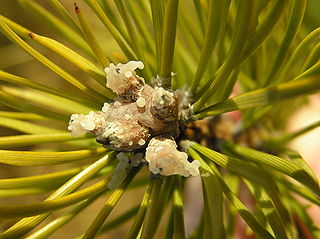
Scleroderris canker, or Brunchorstia disease, Gremmeniella abietina, is a species of fungal diseases infecting coniferous forests. The main symptom is the death of the needles, leading to the death of the tree. In the forest industry, fighting off an infection of Scleroderris canker is usually not cost-effective. Clearing is often preferred over fungicidal methods, as the latter is harmful to other living organisms.

Gremmeniella is a genus of fungi in the family Helotiaceae. The genus contains at least 3 species.
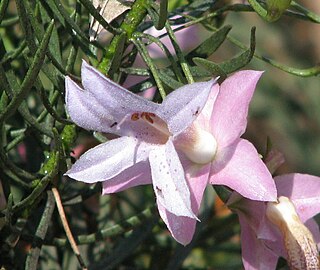
Eremophila abietina, also known as spotted poverty bush, is a plant in the figwort family, Scrophulariaceae and is endemic to a few arid areas of Western Australia. It is a stiff, upright, compact and very sticky shrub with distinctive, dark bluish-green leaves and pale coloured flowers spotted purple.
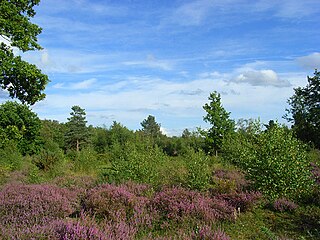
Snelsmore Common is a 104-hectare (260-acre) biological Site of Special Scientific Interest north of Newbury in Berkshire. It is owned by West Berkshire Council and managed by the Berkshire, Buckinghamshire and Oxfordshire Wildlife Trust.

Lecanactis is a genus of crustose lichens, commonly called old wood rimmed lichen. The genus was circumscribed in 1855 by German lichenologist Gustav Wilhelm Körber, who assigned Lecanactis abietina as the type species.

Erica abietina is a species of erica that is endemic to the Cape Peninsula of the Western Cape, South Africa. E. abietina includes four subspecies with often highly restricted distributions and distinctive flower colours. Previous delimitation of the species has included a further three subspecies which proved to be more distantly related to Cape Peninsula endemic E. abietina subspecies and are now classified under Erica grandiflora L.f. and Erica situshiemalis E.G.H.Oliv. & Pirie.

Phaeoclavulina abietina, commonly known as the green-staining coral, is a coral mushroom in the family Gomphaceae. It is characterized by the green staining reaction it develops in response to bruising or injury.
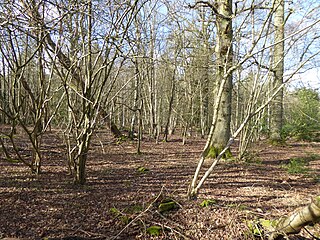
Redhill Wood is a 29-hectare (72-acre) biological Site of Special Scientific Interest west of Newbury in Berkshire.
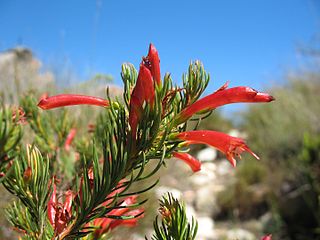
Erica grandiflora is a species of Erica found in fynbos on the mainland Western Cape, South Africa. E. grandiflora was described by Carl Linnaeus the Younger in 1782, and was reclassified as Erica abietina subsp. aurantiaca by Oliver & Oliver in 2002. More recently, phylogenetic analyses of DNA sequence data have revealed that it is more closely related to mainland Western Cape species including Erica viscaria than it is to Cape Peninsula endemic Erica abietina subspecies, and should therefore be treated as a separate species. It includes two subspecies which can be most easily distinguished on the basis of their distinctive flower colours.
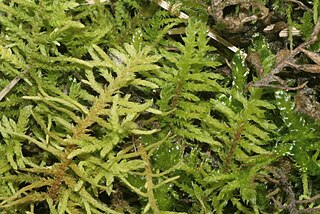
Abietinella abietina is a species of moss in the family Thuidiaceae. It is a small, distinctive pleurocarpous moss with stems that are erect and branches which are spreading, reminiscent of a tiny conifer. Its extremely rare variety abietina is grown with the commoner var. hystricosa on coastal sand dunes. Abietinella abietina is a species which is perennial in terms of growing season, which means it can be found during all months of the year.
Chaenothecopsis vainioana is a species of lichenicolous fungus in the family Caliciaceae that is found in Europe. It was first formally described by Czech lichenologist Josef Nádvorník in 1940 as a member of the genus Calicium. The specific epithet honours Finnish lichenologist Edvard August Vainio. Leif Tibell transferred it to genus Chaenothecopsis in 1979. Calicium vainioanum has been reported growing on Arthonia, Lecanactis abietina, and Calicium salicinum.

Abietinella (plant) is a genus of moss belonging to the family Thuidiaceae.

Dendroalsia abietina is a species of moss. The only species in the genus Dendroalsia, it is a rather large and conspicuous moss. It's easy to recognize when dry, because each stem curls downward like a clenched fist.
Lecanactis rubra is a species of corticolous (bark-dwelling), crustose lichen in the family Roccellaceae. Found in Madagascar, it was formally described as a new species in 2009 by Damien Ertz and Emmanuël Sérusiaux. The type specimen was collected by Sérusiaux from the gorge of Manambolo at an altitude of 300 m (980 ft). At this location, about 3 km (1.9 mi) upstream from Bekopaka, in a dry forest with calcareous soil, it was found growing on bark. This lichen is only known to occur at the type locality.
Rosa abietina is a species of rose that was described by Jean Charles Marie Grenier. Rosa abietina is part of the genus Rosa, and the family Rosaceae.
Gyronactis is a genus of lichen-forming fungi in the family Roccellaceae. It has two species. The genus was circumscribed by Damien Ernst and Anders Tehler in 2014, with G. asiatica assigned as the type species. This lichen, formerly placed in Lecanactis, is only known from the type locality in Myanmar. The genus name alludes to both its similarity with Lecanactis and the presence of gyrophoric acid in the thallus.
Lecanactis borbonica is a rare species of corticolous (bark-dwelling), lichen in the family Roccellaceae. Found exclusively in Réunion, it forms a crustose thallus and is characterised by its rounded ascomata and the presence of specific chemical compounds.
R. abietina may refer to:
Lecanactis minutissima is a species of corticolous (bark-dwelling), crustose lichen in the family Roccellaceae. Found in Sri Lanka, the lichen is characterised by its pale ochraceous thallus and sessile apothecia with dark brown discs, covered with thick white granular pruina.











